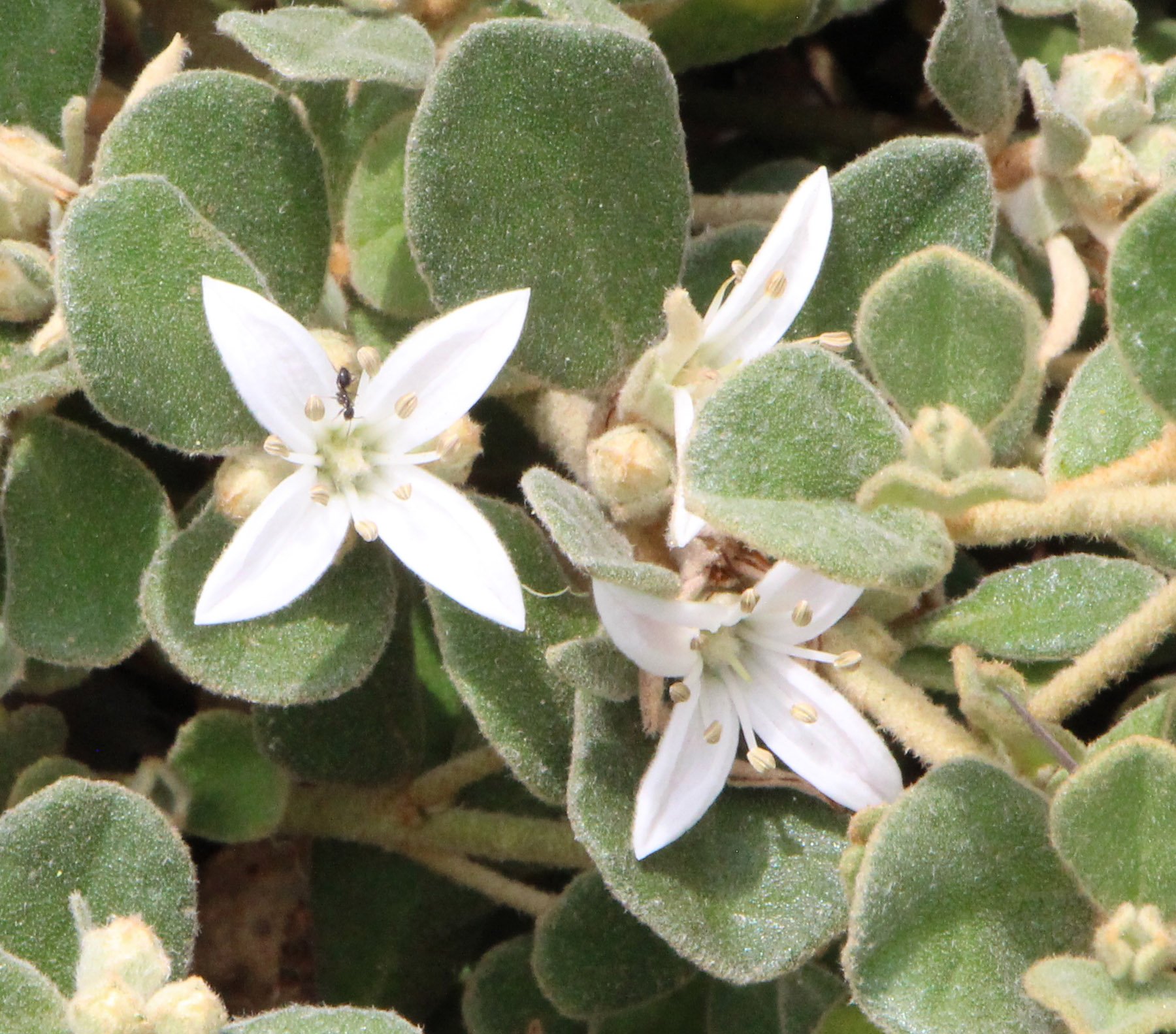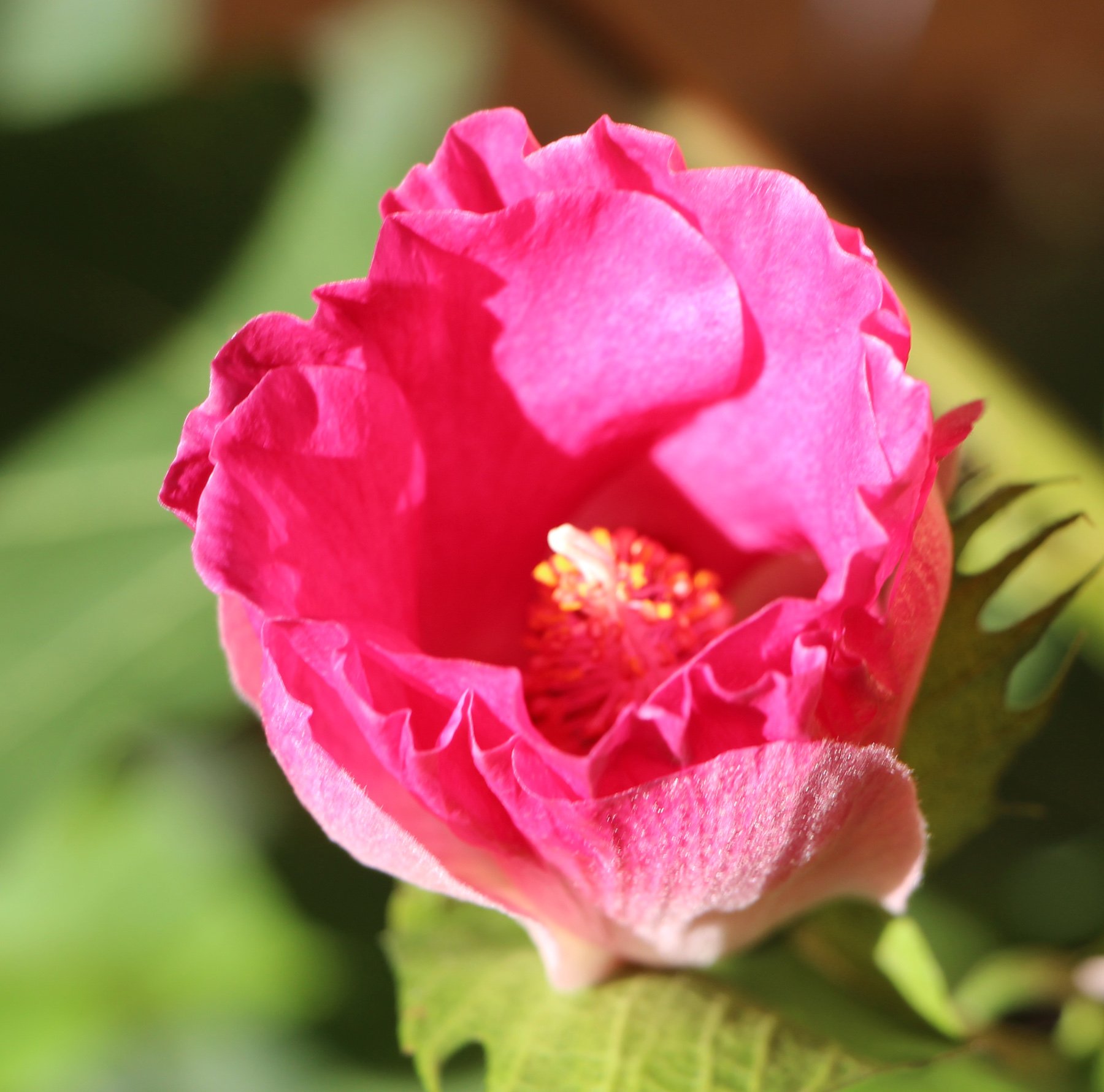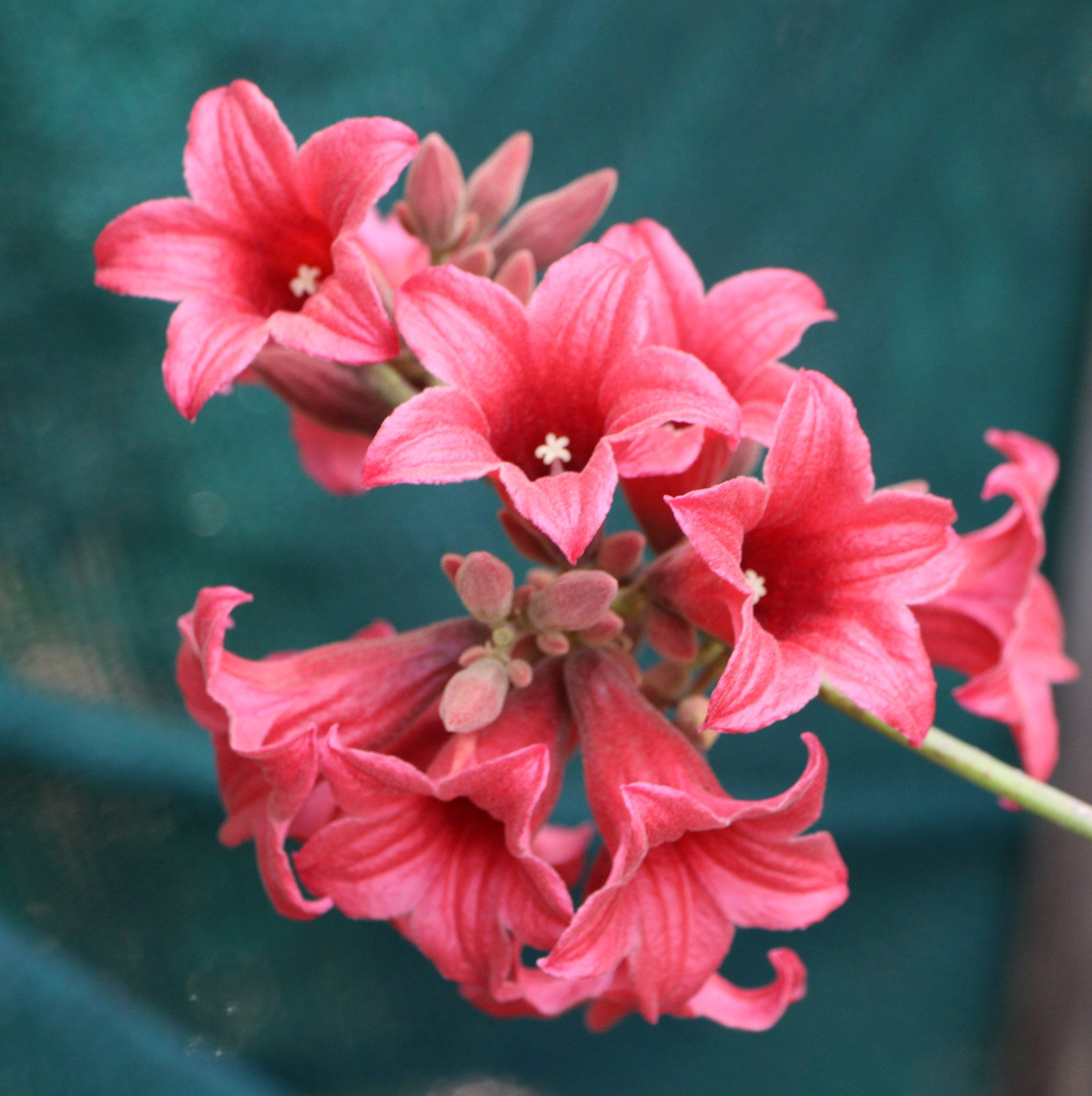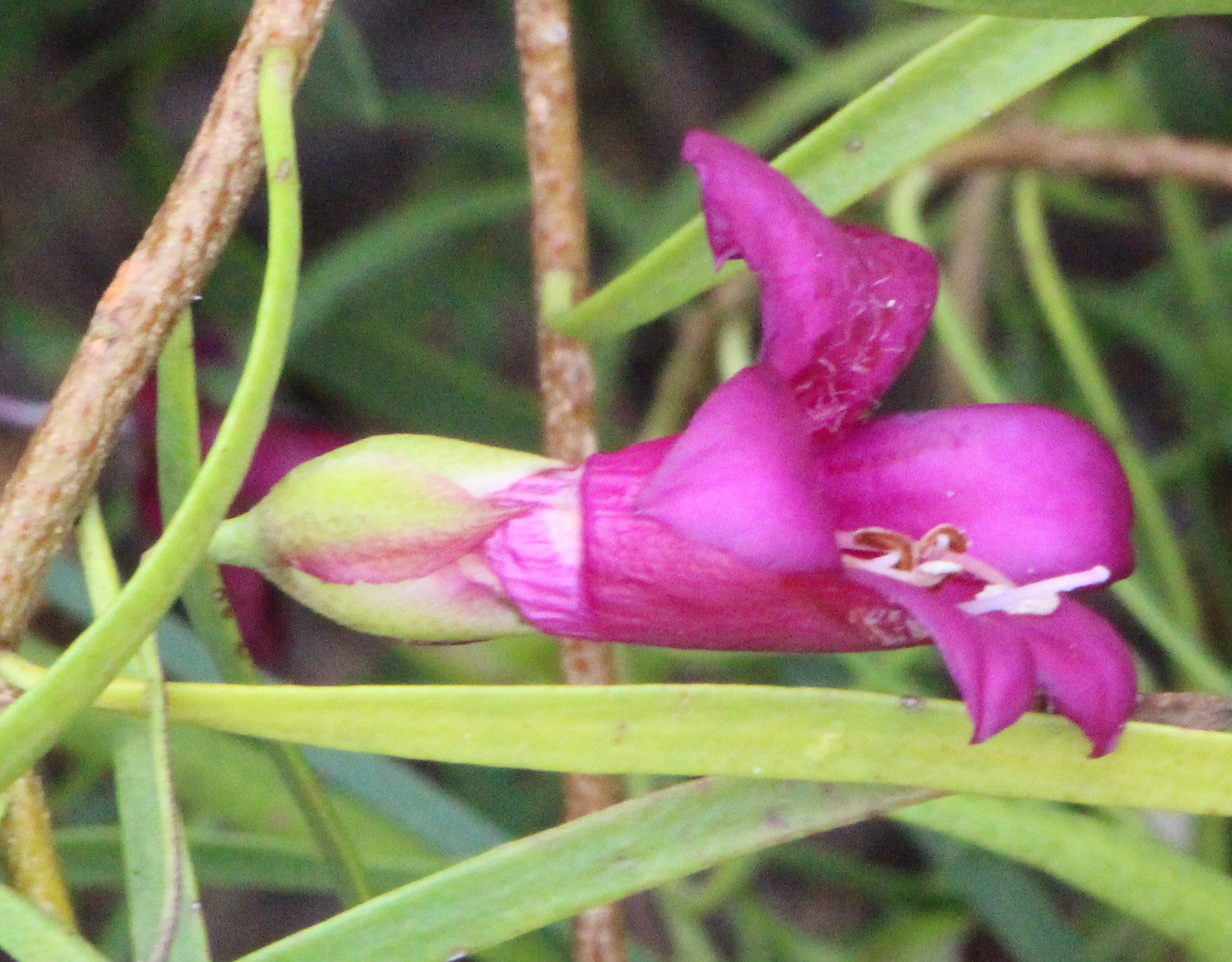January
A few plants that are in bloom in our garden in January
Click once on any image to enlarge and scroll though all the images for each week
Brachychiton ‘Bella Rosa’
29 January 2024
Starting from the top left:
Callistemon ‘Baroondah Station’
Callistemon ‘Baroondah Station’ is a favourite, originally planted in December 2003, so we planted another in December 2019 to replace the one felled by the pine in 2016. The new plant is only small, but I hope that it will grow to 2-3m high and be covered in pale pink blooms like the original.
Callistemon subulatus ‘Brogo Overflow’
Callistemon subulatus ‘Brogo Overflow’ is incredibly successful for us. We have planted a hedge of 20 of these in June 2009. They are planted in a rather inhospitable place where the clay soil has been bulldozed up to form the lip for our large pond. In spite of the wet clay, or maybe because of it, these have prospered, and despite being cut back every year, flower at least twice every year with many red brushes. The new growth is soft and pinkish silver and very inviting to the touch.
Correa alba ‘Star Showers’
We planted this prostrate groundcover, height 0.3m x width 1m, with silver foliage and dainty white star shaped flowers in November 2019. This plant will grow in full sun to dappled shade and is frost tolerant. We planted another four in May 2023.
Gossypium ‘Flirtatious’
We recently planted, in a pot, this very attractive cultivar of Gossypium which flowers in the warmer months with large pink flowers
Grevillea ‘Honey Jo’
Grevillea ‘Honey Jo’, planted in March 2018, forms a medium dense shrub, 2.5m high x 1.5m wide, with linear leaves and many perfumed pink spider flowers, September to April. So far this plant is still small for us, but flowering well.
Pandorea jasminoides ‘Lady Di’
We planted this dense vigorous climber, long-blooming, with many delicate white trumpet flowers with golden throats and a sweet fragrance, in January 2007.
15 January 2024
Starting from the top left:
Correa glabra pink and cream
We planted three of these plants, 1m high and wide, with shiny green leaves and pink and cream bell flowers, in March 2017. This plant is native to NSW, Queensland, Victoria and South Australia.
Grevillea ‘Bush Lemons’
We have tried twice to establish Grevillea ‘Bush Lemons’, grafted specimens, in our garden but have to admit defeat. Our frosty conditions are too severe for this plant. One, planted in March 2013 died in September 2015 after flowering somewhat in December 2013. The other, planted in February 2018, was frosted off in the winter and died in September 2018. In February 2022, we obtained an advanced standard form of ‘Bush Lemons’ in a pot, and two years later it is performing well. The lemon toothbrush flowers last a long time and the deeply divided grey-green foliage is a bonus. This beautiful plant was developed at Changers Green Nursery in Gin Gin Queensland, but the exact parentage is not known.
Grevillea ‘Medika Marvel’
G. arenaria x lavandulacea. We planted this dense shrub, 1.5m high x 1.8m wide, with silvery grey foliage and salmon pink flowers, in February 2021. Best grown in full sun but will tolerate some shade and moderate frosts and needs good air movement. First flowers for us in September 2022 and was still flowering 2 months later.
Hibiscus ‘Barambah Creek’
We planted this upright shrub, 2-3m high x 1.5-2m wide, with soft grey divided foliage and large mauve-pink flowers, in a pot in May 2022. This plant, native to Gayndah/Goomeri area of Queensland, needs a warm sunny position in well drained soil and is tolerant of only light frosts.
Leptospermum morrisonii
We planted Leptospermum morrisonii in May 2009 and this shrub has grown to 2.5m high and first flowered for us in December 2010. The bronzed green leaves are narrow and flowers are white. The bush did not bloom in the extreme heat of December 2019, however flowered very well in the La Nina summer 2021-22. This plant is native from the Blue Mountains to southern NSW.
Stenocarpus ‘Doreen’
We planted this shrub, 2m high x 1.5m wide, with creamy flowers and mid-green foliage, in October 2014.
29 January 2023
Starting from the top left:
Hibiscus ‘Aussie Delight’
We planted this hybrid hibiscus, H. heterophyllus x H. divaricatus, 2m high x 1.5m wide, a fast growing shrub with glossy green leaves, red-brown stems and scented light pink flowers, in March 2021. The stems are covered in irritating hairs.
Hibiscus ‘Barambah Creek’
We planted this upright shrub, 2-3m high x 1.5-2m wide, with soft grey divided foliage and large mauve-pink flowers, in a pot in May 2022. This plant, native to Gayndah/Goomeri area of Queensland, needs a warm sunny position in well drained soil and is only tolerant of light frosts.
Hibiscus geranioides
We planted this annual or biennial species, 0.75m high x 0.75m wide, with dark green, lobed leaves and delicate pink flowers with a darker throat, in a pot in October 2015. This charming plant flowers over many months. We removed our original plant in 2021, as it had grown too large for its position and was not blooming so freely, but the cutting Ben made is growing and flowering well. This plant is widespread in tropical areas of Western Australia, Northern Territory and Queensland. In common with most Hibiscus species, the individual flowers last only 1-2 days but new flowers continue to open over a long period.
Hibiscus heterophyllus ‘Lutea’
We planted this open shrub, 4m high x 3m wide, with lobed leaves and large yellow flowers with maroon centres, in a pot, in March 2022. This plant needs well drained soils, is tolerant of light shade, and must be protected from frost.
Hibiscus heterophyllus pink
Also known as Native Rosella, this hibiscus is endemic to New South Wales and Queensland where it can grow to a shrub or small tree. We planted one in a pot in November 2019. Our plant had its beautiful (but prickly) leaves shredded by hail in January 2020, but they have regrown. The pink flowers are large and showy.
Hibiscus ‘Ian’s Gold’
We planted this hybrid hibiscus, dedicated to the memory of Ian Waldron, in a pot in October 2021. This plant forms a bushy shrub, 2m high x 1.5m wide, with large single gold flowers with a burgundy throat. The reddish stems are prickly. This plant needs a sunny well drained position and tolerates only light frosts, so must be protected in Canberra. We have since moved it into a sheltered spot in the garden as it had grown too large for its pot.
16 January 2023
Starting from the top left:
Angophora hispida
We planted three Angophora hispida, or Dwarf Apple Gum, in 2018. All three are small so far, perhaps 2m, with large drooping leaves and conspicuous white flowers in summer beloved by insects. These plants occur naturally on the central coast of NSW.
Babingtonia (was Baeckea) virgata – Twiggy Baeckea
We planted three Babingtonia virgata, an erect dense shrub or small tree to 4 m with arching branches of dark green, narrow, oblong leaves and masses of loose clusters of small white flowers. This plant is native to the central coast NSW to southeastern Queensland.
Graptophyllum ilicifolium x G. excelsum ‘Holly Hedge’
We planted this low bushy shrub, 1.5m high x 1m wide, with prickly foliage and brilliant red glossy ‘fuchsia’ flowers in a pot in November 2019. This plant had its first flowers in November 2020 and bloomed for two months.
Grevillea ‘Bush Lemons’
We have tried twice to establish Grevillea ‘Bush Lemons’, grafted specimens, in our garden but have to admit defeat. Our frosty conditions are too severe for this plant. One, planted in March 2013 died in September 2015 after flowering somewhat in December 2013. The other, planted in February 2018, was frosted off in the winter and died in September 2018. I am now, February 2022, trying a standard form in a pot, as I admire its many lemon flowers.
Melaleuca lateritia
Melaleuca lateritia, or Robin Redbreast Bush, is a medium shrub, supposedly 1.5m high and wide, although has grown to 2m x 2m in our garden. We planted eight of these in March 2004 on the corners of the parterres near the house. They flowered first for us in January 2005 and have continued to flower over long periods since then. The flowers are bright orange-red, almost Dayglo orange. If these shrubs start to look unsightly you can cut them back to the ground and they will reshoot and flower again in two years. Ben calls them the resurrection plant. This plant is native to southwestern coast of WA.
Melaleuca linariifolia ‘Claret Tops’
We planted three Melaleuca linariifolia ‘Claret Tops’ in the new sand garden in October 2015. These form a dwarf shrub to 1m high x 1.5m wide, with attractive red new growth and many white flowers. They tolerate only moderate frosts so two of the three died in winter ’16, but one remains and has grown and flowered first in December 2018.
2 January 2023
Starting at the top left:
Alyogyne huegelii blue
We planted this shrub, 2m x 2m, supposedly with blue flowers, in May 2020. This plant is native to dry summer areas from South Australia to southern Western Australia in a wide band along the coast. Our plant suffered somewhat from the frost of winter ’21 and its first flowers were not blue, but purple, in October 2020..
Brachychiton ‘Griffith Pink’
We planted this hybrid tree, B. populneus x discolor, height 6-8m, width 3-4m after 15-20 years, with glossy lobed foliage and clusters of pink flowers that appear in summer, in November 2015. The flowers are attractive to birds.This plant had a miraculous escape from fall of the pine in July 2016.. Despite growing really well it lost all its beautiful leaves over winter ’17. This tree had lots of new growth by December 2018 and had no loss of leaves through winter ’19 or since.
Eremophila bignoniiflora x polyclada ‘Big Poly’
We planted Eremophila bignoniifolia x polyclada, or ‘Big Poly’, in April 2008 and after a rocky start this plant has grown to 3m high and wide in our garden. This plant has dark green strappy leaves with white flowers with lilac spotted throats in profusion and responds well to pruning.
Eremophila bignoniiflolia x alternifolia ‘Meringur Isaac’
We planted three Eremophila bignoniiflolia x alternifolia ‘Isaac’ in 2015, 2016 and 2020, height 3-4m, developed from cuttings collected from Ray Schilling’s plants. This very floriferous plant, with purple flowers with spotted throats, blooms for months.
Scaevola ‘Bright Eyes’
We planted two of these groundcovers, prostrate x 1m wide, with white eyed purple flowers on dense green foliage, in April 2021. This plant needs well drained soil in full sun or part shade, and is frost hardy and drought resistant..
Veronica arenaria
We planted 20 of these small to medium shrubs, 0.6-1.5m high x 1-2m wide, with narrow leaves and violet-blue flowers in 2013. Twelve of them have died out over time, but seven remaining and one volunteer in another part of the garden all bloom well. This plant is native from southeastern Queensland to the central west slopes of New South Wales.
31 January 2022
Starting from the top left:
Brachychiton ‘Bella Pink’
We planted this hybrid tree, B. populneus x acerifolius, height 6-8m x width 3-4m, with glossy lobed foliage and clusters of salmon pink bell flowers that appear in summer, in December 2013. The flowers are attractive to birds.
Brachychiton ‘Bella Rosa’ – grafted
We planted a grafted form of this hybrid brachychiton, B. bidwillii x B. spectabilis, in October 2017. This plant reaches about 3-4m high and has dark red flowers in spring and summer on bare branches, followed by lush foliage.
Gahnia sieberiana - Red Sedge
We planted three Gahnia sieberiana, or Red Sedge, around the small pond in November 2005. These flowering sedges can grow to 3m high with leaves up to 1.5m long, with heads of cream and brown flowers in summer. The Red Sedge grows in damp areas of NSW, Queensland, Victoria and South Australia. We removed one of these plants in February 2014 as it had browned off and cut the other two back to the ground in June 2016. The remaining two plants have regenerated well.
Prostanthera serpyllifolia – Small Leaved Mint Bush
We planted this small spreading shrub, 0.5 m high x 0.5m wide, with small aromatic leaves and tubular flowers, variable in colour, red or pink-red, or green tipped magenta or yellow, in September 2020. This plant is native to NSW, Victoria, SA and WA.
Regelia ciliata
We planted this spreading shrub, 1.3m high x 2m wide, with small hairy leaves and mauve flowers with gold tipped stamens, in September 2018. Regelia - in honour of Eduard August von Regel (1815-92), superintendent of the botanic garden at St Petersburg, Russia ciliata - from Latin, fringed with fine hairs (the leaves are hairy). Native to southwestern west coast of WA. First flowers 1/22.
Sannantha angusta (Baeckea) Clarence River – Weeping Baeckea
We planted this open shrub, 2-3m high x 1-2m wide, with weeping branches of narrow dark green leaves and small white flowers, in November 2017. Our plant has grown very little, only to 0.5m high so far, but flowers every year.
24 January 2022
Starting from the top left:
Acacia pruinosa
We planted, in November 2011, one of these small trees to 6m high with red to purplish bark and glaucous branches, ferny foliage with red new growth, attractive seed pods and sprays of golden ball flowers in January. This tree is native to New South Wales and Queensland.
Correa alba ‘Star Showers’
We planted this prostrate groundcover, height 0.3m x width 1m, with silver foliage and dainty white star shaped flowers, in November 2019. This plant will grow in full sun to dappled shade and is frost tolerant.
Eremophila drummondii
We have planted four of these shrubs, 0.5-1.3m high x 0.5-1m wide, with narrow sticky leaves and purple tubular flowers, from 2011-2018. The oldest one was removed 2013 and the compact form died 2019, and one of the broad leaf forms in 2021. We have one broad leaf form remaining. This plant is native to southwestern Western Australia.
Eucalyptus ‘Summer Beauty’ grafted
We planted this hybrid gum, E. ficifolia x E. ptychocarpa, with bronze new foliage, large pink flowers with gold tipped stamens and yellow centres, in a pot in December 2020.
Grevillea x semperflorens
Grevillea x semperflorens’ (photos above) was sold to us as ‘Mallee Dawn’ but Peter Olde quickly identified it for us as x semperflorens’, one of the earliest hybrid grevilleas ever produced. This cultivar was developed in England and was first formally described in 1937 by F.E. Briggs in The Journal of the Royal Horticultural Society of London as Grevillea semperflorens. We planted three in September 2007 and quickly realised our mistake as they grew much too large for their position and had to be removed. We planted another in February 2019 in a better spot, but this one disappeared for a few months, but has now reappeared and is flowering. The flowers are a lovely soft apricot colour.
Leptospermum brachyandrum
Leptospermum brachyandrum, or Silver Weeping Tea Tree, is an attractive small tree with silver foliage and white flowers in spring. This tree can be 3.5m high and 2-3m wide, but in our garden has grown very slowly to 1.5m high. We planted six from 2013-17 and our first blooms were in December 2015. We planted these plants on the edge of our large pond to ensure that they had a continual source of moisture. This plant is native to coastal regions of NSW north of Port Macquarie and coastal Queensland.
11 January 2022
Starting from the top left:
Alyogyne huegelii ‘Misty’
We planted three of these shrubs, with attractive bluish foliage and many lilac flowers with burgundy centres, in December 2018. These plants bloom very generously over several months.
Angophora hispida
We planted three Angophora hispida, or Dwarf Apple Gum, in 2018. All three are small so far, perhaps 2m, with large drooping leaves and conspicuous white flowers in summer beloved by insects. These plants are native to the central coast of NSW.
Banksia serrata – Old Man Banksia, Saw Banksia
We planted one Banksia serrata or Old Man Banksia, 10 to 15 m high, in December 2003 . The rigid deep green leaves are coarsely serrated and the flowers are a beautiful silvery grey at first, opening to a yellow-green color as the flower matures. The flowers appear from spring through autumn and are followed by large grey cones. This tree has grown well and is developing the wrinkled trunk that makes older specimens so attractive. This banksia is widespread in eastern Australia, in open forests of the coasts and mountains of Tasmania, Victoria, NSW and Queensland. Our tree bloomed well for a couple of years, but has not bloomed now for five years. Why? The answer may be rain, as in this rainy La Nina year of 2021 our banskia is covered in buds., now over forty flowers in January 2022.
Eucalyptus ‘Nullarbor Lime
We planted ‘Nullarbor Lime’, E. pyriformis x macrocarpa , in November 2014. This small tree is a hybrid of two iconic WA eucalypts combining large lime green flowers, grey foliage and upright habit. Height 3-4m x width 3m. This tree has large flowers followed by beautiful nuts, but was stripped of most of its flowers by the fall of a large branch of E. sideroxylon in November 2020..
Eremophila maculata ‘Passionate Lady’
We planted two of these evergreen compact shrubs, 1m high x 1m. wide, with deep pink blooms, in February 2019. Apart from being eaten by our two resident hares in October 2020, these plants are thriving. Ian Tranter says that it is very similar to E. ‘Meringur Crimson’.
Lythrum salicaria – Purple Loosestrife
We planted 5 of these erect perennials in 2004-5, growing to 2m with opposite leaves and spikes of purple flowers in late spring or summer. This plant is native to southeastern Australia and also to Europe, Asia and North America. Our plants have naturalized around the pond where their roots are in the water. We now have possibly 100 plants.
4 January 2021
Starting from the top left:
Hibiscus heterophyllus pink
Also known as Native Rosella, this hibiscus is endemic to New South Wales and Queensland where it can grow to a shrub or small tree. We planted one in a pot in November 2019. Our plant had its beautiful (but prickly) leaves shredded by hail in January 2020, but they have regrown. The pink flowers are large and showy.
Pelargonium australe
We have planted about ten of these rounded plants, 0.5m diameter, with pink-mauve flowers with darker markings for long periods. This plant is hardy in most soils in full sun and self seeds. This plant is native to all states.
Podolepsis hieracioides
We were gifted two of these woody perennials in February 2019. They grow to 70cm high with yellow flowers, and are native to the southern half of NSW and Victoria. The plants disappeared for the winter but reappeared in spring and have spread since then.
Stenocarpus ‘Doreen’
We planted this shrub, 2m high x 1.5m wide, with creamy flowers and mid-green foliage in October 2014.
Viola banksii (was V. hederacea) – Ivy Leaf Violet
A spreading ground cover which will form extensive mats up to 2m across of small, round, ivy-shaped leaves on long thin runners. The white and purple flowers are produced on upright stems for a long period from spring to winter. We planted 85 of these in 2003-4 and those planted in the shade survived. These plants are native to Queensland, NSW, Vic, Tasmania, SA, and Malaysia.
11 January 2021
Photos above starting from the left:
Acacia pruinosa
We planted, in November 2011, one of these small trees to 6m high, with red to purplish bark and glaucous branches, ferny foliage with red new growth, and sprays of golden ball flowers in January. This tree is native to New South Wales and Queensland.
Babingtonia (was Baeckea) virgata – Twiggy Baeckea
We planted three Babingtonia virgata, an erect dense shrub or small tree to 4 m, with arching branches of dark green, narrow, oblong leaves and masses of loose clusters of small white flowers, in 2003. These have since been severely cut back, but still flower each year.
Correa reflexa x decumbens ‘Redex’
We have planted about 30 Correa ‘Redex’, a most attractive small shrub with red and yellow bird-attracting flowers, which appear through summer and again from autumn to winter.
Eremophila bignoniiflora x alternifolia ‘Meringur Isaac’
We planted Eremophila bignoniflora x alternifolia ‘Isaac’ in March 2015, 3-4m, developed from cuttings collected from Ray Schilling’s plants.. This very floriferous plant blooms for months. and is now 2m high in our garden.
Eremophila glandulifera ‘Lipstick Pink’ - grafted
We planted this upright shrub, with attractive grey foliage and lolly pink flowers, in a pot, in December 2019. This plant is from central WA and grows to a height of 1.5m.
18 January 2021
From the top left:
Anigozanthos flavidus ‘Landscape Red’
We planted 20 Landscape Red kangaroo paws in May 2015. This line, bred by Angus Stewart, is a tough and tall variety of Anigozanthos flavidus. Birds love the flowers.
Banksia victoriae - Woolly Orange Banksia
We planted, in a pot, in November 2013, Banksia victoriae, a tall shrub to about 5 metres high, with linear leaves, deeply lobed with triangular teeth and orange, ‘acorn shaped’ flower spikes. This plant grows in sandy soils in a restricted area northwest of Geraldton in Western Australia.
Gossypium ‘Flirtatious’
We recently planted, in a pot, this very attractive cultivar of Gossypium which flowers in the warmer months with large pink flowers
Grevillea hilliana – Hill’s Silky Oak
We planted this interesting grevillea in July 2020, which is named after the discoverer of the species, Walter Hill, 1820-1904. This plant is densely crowned with lush dark green leaves and develops hanging racemes of clusters of small white flowers. This plant is native to coastal Queensland and is relishing the extra rain of the La Nina years 2021-22.
Grevillea insignis (grafted 31/10/09 on G. robusta) – Wax Grevillea
We were gifted a grafted specimen of this dense prickly shrub, 3m high x 2.5m wide, with rigid, holly shaped blue-green leaves and pendant clusters of glowing pink waxy flowers from Phil Trickett in June 2010. This plant is native to southwestern WA. The veined leaves are extremely beautiful with the sun shining through them.
27 January 2021
From the top left:
Eremophila glabra subsp. Arrowsmith
We planted two of these vigorous shrubs in 2014, 1.5m high and 1.5m wide, with bright green leaves and masses of bird attracting yellow flowers in late winter and spring. We cut one to the ground 1/21 and will wait to see if it will reshoot - did not.
Scaevola ‘Sitting Pretty’
We planted three of this Scaevola humilis selection, bred by Peter Abell, with pink flowers and a spreading habit to 1m wide, in February 2015. Two plants have thrived and the other one is poor.
Syzygium australe
We planted three of this compact form of Syzygium australe, to 3m, in December 2008. Shiny red new growth is often frosted off in our climate but regrows. Many fluffy white flowers are borne over a long period. These plants are enjoying the extra rain of the La Nina years, 2021-22, and are growing vigorously.
Westringia ‘Deeppurple’
We have planted 45 plants since 2012 of this form of Westringia ‘Wild River’, a small shrub, height 50cm, width 50cm, with lush green leaves and deep purple flowers throughout the year from plant breeder Ian Shimmen.
Xerochrysum bracteata ‘Lemon Queen’
We planted three of these small plants in September 2019, with large, papery, yellow flowers throughout the year held above mid-green foliage, height 1m x width 1m.
3 January 2022
Starting from the top left:
Acacia subulata – Awl Wattle
We planted this small tree, 1.5 – 4m high and 1-2m wide, with a slender habit, narrow graceful foliage and showy yellow ball flowers, in August 2016. This plant is native to northeastern NSW along the ranges and slopes. This wattle blooms all year, in a serial fashion, from branch tip upwards, smells delicious, has delightful light ferny foliage, decorative seed pods and grows fast.
Brachychiton bidwillii - Little Kurrajong
Brachychiton bidwillii, planted in a pot in 2013, has grown to 3 metres tall. This plant needs protection from the frost as it comes from dry rainforest from southeastern Queensland to Bowen in the north. The foliage is one of its distinctive features with five lobed felty leaves reminiscent of a human hand. The flowers are bell shaped and coral red, coming for us appropriately at Xmas. Flower production is supposed to increase with age, so we are looking forward to even more flowers in future. The bare branches are covered in flowers in January 2022.
Leptospermum morrisonii
We planted Leptospermum morrisonii in May 2009. This shrub has grown to 3m high and first flowered for us in December 2010. The bronzed green leaves are narrow and flowers are white. The bush did not bloom in the extreme heat of December 2019, but is flushed with bloom in January 2022. This plant is native to Blue Mountains to southern NSW.
Lomatia arborescens
We planted this tall shrub or small tree, 6m high by 3m wide, with light green oblong leaves with toothed margins and sprays of cream flowers, in April 2005. This plant has attractive glossy foliage and enjoys heavy shade and well composted soil. This plant is native to the area north from Barrington Tops, NSW to southeastern Queensland.
Lomatia myricoides
We planted eleven of these rounded open shrubs or small tree, 5m high by 3m wide, with dark green, narrow, sparsely toothed leaves and sprays of cream flowers, in December 2003, as part of our foundation planting. This plant is hardy in shade or sun and the flowers are suitable for cutting. These plants are native to open forests of eastern NSW and Victoria, usually in moist locations. We cut all these plants back to the ground as all were browned off in the heat and dryness of January 2014 – all were eventually removed except one, which continues to flower well each year.
Melaleuca lateritia
Melaleuca lateritia, or Robin Redbreast Bush, is a medium shrub, supposedly 1.5m high and wide, although has grown to 2m x 2m in our garden. We planted eight of these in March 2004 on the corners of the parterres near the house. They flowered first for us in January 2005 and have continued to flower over long periods since then. The flowers are bright orange-red, almost Dayglo orange. If these shrubs start to look unsightly you can cut them back to the ground and they will reshoot and flower again in two years. Ben calls them the resurrection plant. This plant is native to southwestern coast of WA. they have never flowered so well as they have in this La Nina year, 2022.











































































